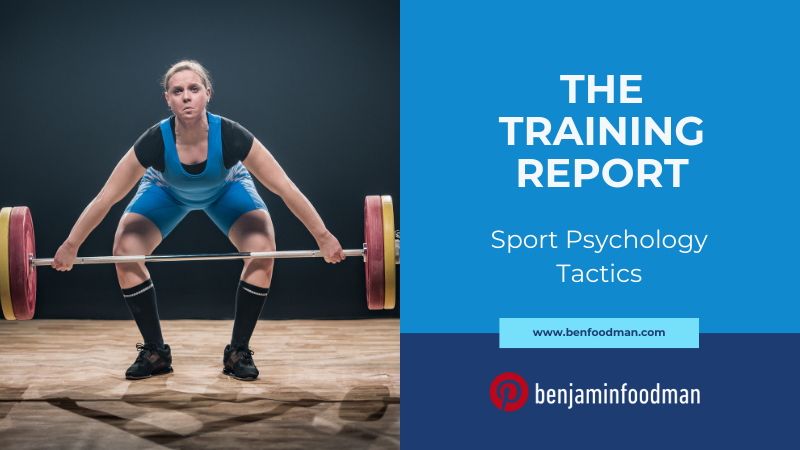Sport Psychology Tactics - An Expert Cure For Race Car Driver Mental Blocks & The Yips
About the Author
Ben Foodman is a licensed psychotherapist & performance specialist. He owns his private practice located in Charlotte North Carolina where he specializes in working with athletes to help them overcome mental blocks (the yips), PTSD, ADD / ADHD and achieve flow states through the techniques of Brainspotting & Neurofeedback. If you are interested in services, use the link here! Enjoy the article below!
Table Of Contents
Introduction: How Top Sport Psychologists Cure The Yips For Race Car Drivers
Part I. How Sport Psychologists Answer ‘What is the Yips’ For Race Car Drivers
Part II. How Athlete Mental Counselors Explain Race Car Driver Psychology Of The Yips
Part III. Why Brainspotting Can Be A Race Car Driver’s Yips Cure
Introduction: How Top Sport Psychologists Cure The Yips For Race Car Drivers
I have written extensively about the Yips in previous Training Reports as it relates to motorsport athletes. While the Yips is something that affects all athlete populations, motorsports is an area where I have extensive applied experience, specifically with professional racecar drivers. Apart from being located in the motorsports ‘hub’ of the United States in Charlotte, North Carolina, I believe one of the other main reasons these athletes deal with this issue so much is because of how physically and mentally grueling the sport of professional race car driving can be. If any part of a driver’s psychology is dealing with an unresolved issue, it will reveal itself during the race.
For this issue of the Training Report I wanted to take some time to review new and additional information as it relates to the Yips in professional race car drivers. For part I. I am going to spend more time identifying how sport psychologists define the Yips for professional race car drivers. For part II. I will then review the neuropsychology that explains what happens in the brain to create the yips. Finally, in part III. I will review a potential yips ‘cure’ that many sport psychologists are turning to that can help professional race car drivers. Let’s go ahead and begin by reviewing why motorsports create issues such as the Yips and how sport psychologists define this issue.
Part I. How Sport Psychologists Answer ‘What is the Yips’ For Race Car Drivers
Whether you are watching race car drivers compete in 24 Hours of Le Mans, the NASCAR Cup Series, F1 or any other motorsport competition, you will have some sense of how mentally demanding the sport is. I have been fortunate to work with many elite drivers in the NASCAR promotions, as well as other high level performers in other sports such as Major League Baseball, professional golf, Olympic athletes, as well as college and NFL athletes. Based on my experience, racecar driving is just as mentally demanding as any of the previously mentioned sports. Racecar drivers are required to process vast amounts of information, and make high level split decisions in a matter of milliseconds while also anticipating potential future outcomes of where they are in the race. Combine this with the physical demands that the racecar places on these athletes, and you have individuals who are always at high risk for dealing with what is commonly referred to as the Yips. But many people may not be familiar with what the Yips is or how it is defined.
Many sport psychologists commonly refer to the Yips as ‘Focal Dystonia’ in order to provide what appears to be a more clinical term on the surface. Other neuroscientists will refer to the Yips as a psychological phenomenon that is simply ‘random muscle spasms’ that occur to athletes in high pressure situations. The fact of the matter is that 99% of these so called ‘experts’ have it 100% incorrect. The yips are not random muscle spasms or ‘focal dystonia’. The yips are a defense mechanism that is produced when the athlete feels that they are at risk or unsafe. This theory was originally developed by Dr. David Grand, a former EMDR (Eye Movement & Desensitization Reprocessing) Trainer and founder of the new psychotherapy technique called Brainspotting. Through his work with elite athletes he eventually came to the correct conclusion that traditional sport psychology had it completely wrong when it came to understanding this issue. He recognized that the Yips could be understood through what is commonly known as a ‘trauma-informed’ perspective, and to really get a sense of what is going on we first need to dive into what happens to a race car driver’s brain when the Yips occurs.
Part II. How Athlete Mental Counselors Explain Race Car Driver Psychology Of The Yips
As I have previously mentioned, the Yips is a psychological defense mechanism that certain parts of an athlete’s brain employs. One of the leading experts in the world on this issue provides an excellent description of this mechanism. In the book The Body Keeps The Score, Dr. Bessel Van Der Kolk explains the process of how the brain respond to stress (or trauma), which in turn can lead athletes towards regressing mentally in racing performance, thereby creating the Yips: the emotional brain has first dibs on interpreting incoming information. Sensory information about the environment and body state received by the eyes, ears, touch, kinesthetic sense, etc. converges on the thalamus where it is processed and then passed on to the amygdala to interpret its emotional significance. This occurs with lightning speed. If a threat is detected, the amygdala sends messages to the hypothalamus to secrete stress hormones to defend against that threat. The neuroscientist Joseph LeDoux calls this the low road. The second neural pathway, the high road, runs from the thalamus via the hippocampus and anterior cingulate, to the prefrontal cortex, the rational brain, for a conscious and much more refined interpretation. This takes several microseconds longer. If the interpretation of threat by the amygdala is too intense, and/or the filtering system from the higher areas of the brain are too weak, as often happens in PTSD, people lose control over automatic emergency response, like prolonged startle or aggressive outbursts.
One area of research that is connected to the mechanisms that Dr. Van Der Kolk described is in the field of HRV research, and the larger impact that the autonomic nervous system has on athlete’s mental performance. Dr. Stephen Porges, one of the more well-known experts within the field has made groundbreaking discoveries and provided excellent descriptions about how this system works. Per his website, the following quote illustrates important characteristics of this system, “The mind and body are connected through the Vagus nerve, the longest nerve in the autonomic nervous system, stretching from the brainstem to the colon. It is our internal control center, allowing the brain to monitor and receive information about many of our bodily functions”. We know from research that athletes and other individuals with low HRV have issues associated with mortality, myocardial infarction, coronary heart disease, and congestive heart failure. But the Vagus nerve also influences our brain’s fight, flight, freeze responses as well. Overtime if left unchecked, as the racecar driver’s brain adapts to the stress experienced in racing (and outside of competition) the athlete’s brain will predictably and reflexively adapt in ways that are not ideal for peak performance outcomes. One of these ways is through the creation of Yips responses.
In the book This Is Your Brain On Sports by David Grand, the author goes into great detail to explain the neuroscience behind the sports-related stress and how the brain generates the Yips reflex responses. The author describes as follows ‘In parallel fashion, the brain attempts to always move toward a state of psychological equilibrium. Over the course of our lives, we are exposed to a variety of life experiences, some positive, some neutral, and some negative. Through a natural assimilation process, the brain adaptively processes these experiences so they are constructively integrated. What is useful from the experience is learned and stored in the brain with the appropriate emotion and is available for future use. When an experience is successfully assimilated or digested it is stored in the brain with little attached intense emotion or physical sensation. When we recall such an incident, we don’t reexperience the old emotion or sensation with it. In this way we are informed by our past experiences and memories but not controlled by them and with sports our present athletic performances are not burdened by emotional or physical baggage from the past, only learned experience. By contrast, trauma or any strongly negatively charged experience isn’t adequately assimilated or processed. Instead, the upsetting incident remains stuck in the system in broken pieces’.
The author continues, ‘ The body instantly memorizes the physical experience of the trauma in exquisite detail, including the body sensations of the impact and pain, along with the associated sights, sounds, smells and tastes. The attached emotions and where they are felt in the body are frozen as well. The brain is overwhelmed and instead of getting digested, all of the information attached to the injury, including the negative thoughts is stored in the brain in exactly the same form it was initially experienced. Days, week, months or even years later when the athlete is in a situation reminiscent of the original trauma or experiences prolonged stress, the upsetting experience may be unconsciously activated, thus interfering with the performance of the moment. These components represent all of the sensory details from the earlier event that were frozen in the brain and body in their original disturbing state: the images, lighting, emotions, physical movements, sounds, or smells. The unique sensory details later returning to consciousness cause the performance disrupting symptoms so common in mental blocks.’ Some people might question if this is an isolated opinion about sports yips. In some ways it is because as I have mentioned previously, the majority of sport psychologists have limited training on the mechanisms of trauma on the brain. But leading experts such as Dr. Bessel Van Der Kolk, Dr. Stephen Porges & Dr. David Grand add weight to the validity of this argument. So now that we have established an introductory understanding of what the Yips actually is, let’s review a possible ‘cure’ that sport psychologists and athlete mental counselors can employ to help athletes and racecar drivers train their brains out of the yips: Brainspotting.
Part III. Why Brainspotting Can Be A Race Car Driver’s Yips Cure
Brainspotting is a brain-based psychotherapy technique that utilizes the client’s field of vision to identify unresolved psychological issues. In Brainspotting we say ‘where you look affects how you feel’ and through this process clients have the ability to access the parts of their brain that traditional psychotherapy approaches such as cognitive behavioral therapy are unable to do. This results in clients being able to directly address the true ‘underlying’ issue (which we refer to as a Brain Spot) that has created conflict allowing individuals to move from needing to constantly cope, to not needing to cope at all. Brainspotting can be used to help anyone who is dealing with mental blocks, the yips, psychologically traumatic events, chronic pain issues from injuries, as well as individuals who are trying to access deeper levels of creativity or cultivating mental flow states. When we think about the potential issues that racecar drivers deal with such as concussions, TBIs, car crashes, witnessing colleagues crash, sport humiliations, sports-injuries, out of sport trauma (e.g. car accidents, interpersonal relationship issues), it can be easy to see why this intervention pair perfectly with this athlete population.
The goal of all psychotherapy interventions are to help clients move from dysregulation to regulation. For instance if you are a racecar driver and you have been experiencing mental blocks such as increased pre-performance anxiety or fear responses, this can be considered a state of dysregulation. Because almost half of the brain is dedicated to vision, we use the client’s field of vision combined with focused mindfulness to help engage the regions of the brain that are responsible for regulation and bypass the regions that are not! This physiological approach can help clients achieve their desired psychological outcomes. When athletes work with a sport psychologist who uses Brainspotting, they will first identify what the issue is that they would like to resolve. These issues can range from experiencing pre-performance nerves in sports, to having anxiety about speaking in front of large groups. Clients discuss the issue in-depth and then the sport psychologist invites clients to have their eyes follow a pointer that the clinician will move in certain directions to identify the eye position that is relevant to the topic that the client is looking to resolve. Once the eye position is identified, the client will hold that eye position for either several minutes up to two hours potentially until the issue is resolved. If you would like to learn more, please use this link!
Note To Reader:
If you are an athlete reading this segment of the TRAINING REPORT, hopefully this content was helpful! I put the Training Report together because I felt like many of the discussions on issues such as the Yips/mental blocks, strength training & other subject matter on athlete performance concepts were really missing the mark on these ideas (e.g. how trauma is the direct cause of the Yips). If you are interested in learning more, make sure to subscribe below for when I put out new content on issues related to sport psychology & athlete performance! Also, if you are looking to work with a mental performance specialist, you are in the right place! USE THIS LINK to reach out to me to see if my services are the right fit for your goals!
ARE YOU ON THE LIST?
Make sure you’re signed up to Ben’s mailing list to receive news & updates on new strategies in sport psychology, upcoming workshops & products. Don’t wait, sign up now!

















































































